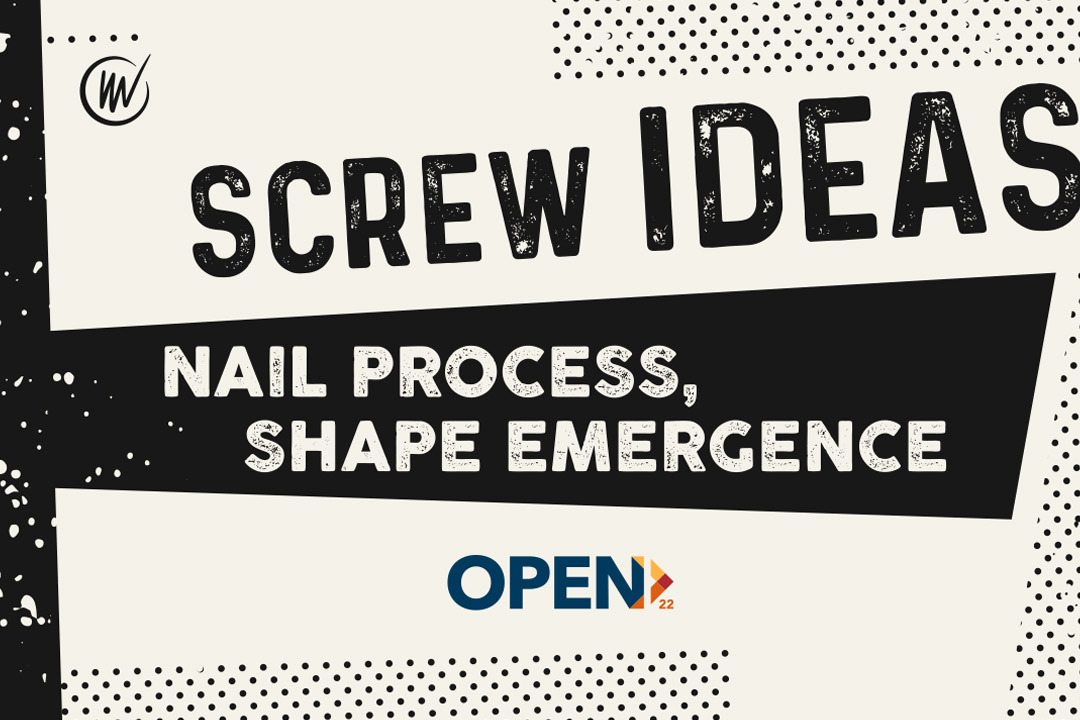
Six innovation and entrepreneurship faculty panelists have launched a manifesto: Screw Ideas: A Manifesto for Engaged and Emergent Innovation, which poses a bold idea: Ideation-focused innovation does not lead to new, relevant, or impactful solutions—and there is a better way.
At the OPEN 2022 Screw Ideas session, VentureWell’s Victoria Matthew joined:
- Professor Soyoung Kang of University of Washington-Seattle Campus
- Professor Iain Kerr of Montclair State University
- Professor Jason Frasca of Montclair State University
- Professor Khanjan Mehta of Lehigh University
- Dr. José Lugo of University of Puerto Rico-Mayagüez
- Dr. Mari Luz Zapata Ramos of University of Puerto Rico-Mayagüez
The panel discussed how the manifesto’s three-pronged approach—screw ideas, nail process, and shape emergence—provides the pedagogical structure faculty need to rethink and redesign how to support student innovators to maximize impact.
Background
A few years ago, Iain and Jason first began to question the effectiveness of ideation-based learning while at OPEN. During a session, a student shared that once they headed into the field, they learned their grant-winning venture idea was completely removed from the reality of the problem they were trying to solve. This led Iain and Jason to start rethinking idea-based innovation—they ultimately realized that innovation curriculum is centered almost entirely on idea development and is constrained by academic structures and timelines. Students end up designing innovations within compressed time frames without truly understanding the problem or the impacted community’s perspective.
During the Screw Ideas session, the panelists shared how they’ve revamped the I&E process so it’s firmly grounded in the reality of the social, environmental, and health challenges the students seek to solve. Below, we’ve broken down the core tenets of the Screw Ideas manifesto and shared key insights from the session. Watch the full OPEN session to learn more.
Screw Ideas
Learn from the world
Get your students out of the classroom or lab and into the world to help them learn about real-life problems. Khanjan explained that a sign you are on the right track is when students say, “I have no idea,” rather than “I have an idea.”
Mari Luz explained that it’s important to “…challenge and transform students’ mindset of ‘I think this is what’s happening’ and into ‘I’ve seen that this is what’s happening, I’ve heard that this is what’s happening.’”
No ideas, but in making and doing
Collaboration and experimentation are at the core of designing novel solutions.
“If you’re trying to do something innovative or new, you’re trying to do something that does not exist,” explained Iain. “You can’t really ideate at that moment because ideas draw from previous experiences and concepts. Everything you can think of already exists. When we talk about innovation, we have to get outside of thinking.”
Nail Process
Engagement invents its own process
Academic structures are not aligned with entrepreneurial processes, and grading based on solution outcomes is antithetical to innovation—entrepreneurs need space to try, fail, and try again.
Soyoung emphasized stretching outside of and supporting students beyond a single semester class. “We lean very heavily on the I&E ecosystem and really encourage students to participate in university innovation programs, which don’t necessarily follow academic systems or timelines,” said Soyoung. “By testing projects outside of the classroom, students realize there are metrics that they can use to assess their projects aside from grades.”
Foster student competency in the process
Process is more important than outcomes. If students learn the process, they’ll be able to take those skills with them in whatever they do; however, if they are solely focused on a venture or idea, they’ll have a much more limited skill set.
Shape Emergence
Calibrate externally; create collectively
Convene students around areas of interest and ground them in a community-centered practice that emphasizes iteration and collaboration with each other and external stakeholders.
“It’s about opening their minds to what else is possible,” said Jason. “We’re not focusing on giving answers, but rather, on bringing in people that have a broader perspective to help elevate and amplify the student’s work, and help them see new directions, pathways, and opportunities to move forward.”
The goal is not a ‘solution’
Students need to learn how to innovate, not how to create an innovation. The goal should be “living” solutions that are meaningful, self-sustaining, and can evolve over time.
“We’re building innovators, not startups,” said José. “If we look at the number of startups we’ve created, we definitely failed—but when we look at what the students have done after our program, we see that students are innovating in fields that are not typical for engineering or business students.”
Support the student journey from embedded learning, to theory, to practice, to expertise
Students need access to resources and mentorship across their innovation journeys. Your ongoing support will enable them to reinvest in—and strengthen—the I&E ecosystem.
“I always go back to Edwin Markham’s famous lines: ‘Why build these cities glorious if man unbuilded goes? We build the world in vain unless the builders also grow,’” said Khanjan. “We are here to do both.”
Read the manifesto and watch the complete recording for a deeper dive into the thinking behind the Screw Ideas manifesto.
Ready to expand or launch your own I&E course? Apply for a Course & Program Grant to kickstart impact-driven innovation on your campus.